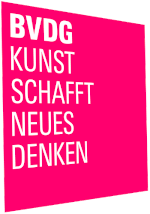The context of an oeuvre
Artist, work and viewer are in constant movement. The process of creation, the painting as product, music as an ally and the essence of painting, can be compared to an extensive network of walks.
Each painting comes into being over a long period. Each work passes through several stages. There is no set plan. Just as a composer allows his composition to take shape, in Bart Vandevijvere’s work the plan for and the genesis of the painting coincide.
 Like intertextuality in literature, his oeuvre refers to the tradition of painting. In each image we see echoes of Constructivism, Suprematism, geometric painting, Abstract Expressionism, post-painterly abstraction and the Neue Wilde movement. As a child of abstract painting, Bart Vandevijvere travels onward with a suitcase full of elements from recent art history. His work is related to it yet tears itself loose. At the same time, each work is a unique contemporary painting with a character typical of Vandevijvere.
Like intertextuality in literature, his oeuvre refers to the tradition of painting. In each image we see echoes of Constructivism, Suprematism, geometric painting, Abstract Expressionism, post-painterly abstraction and the Neue Wilde movement. As a child of abstract painting, Bart Vandevijvere travels onward with a suitcase full of elements from recent art history. His work is related to it yet tears itself loose. At the same time, each work is a unique contemporary painting with a character typical of Vandevijvere.
‘In between’ is a reference to the network in the broad field of art in general and forms of painting in particular. In terms of content, we are moving from one extreme to the other and back.
For Bart Vandevijvere, painting is a continuous cyclical movement between aesthetic and non-aesthetic, thinking and doing, and building up and breaking down. He sees painting as a permanent and challenging attitude, ranging from restraint to the ability to resolve, from fragility to brutality, of rejection and seduction.
Music is never far away. It is a cyclical movement in parallel with the seasons. In the summer he does large paintings in the garden. The ‘Garden Painting Session’ shows traces of the ambient sounds; they vary from annoying lawnmowers to cheerful birdsong. Working in bright sunlight leads to reflections on the white paint. The paint dries a lot faster. In the late summer the painter returns to the closed world of the studio, where he can choose the music that’s played. Painting also means walking from the free outdoors to the intimacy of the painting room and vice versa.
 The pleasure of painting in a walking network full of junctions
The pleasure of painting in a walking network full of junctions
Bart Vandevijvere’s paintings are infectious. If you walk with him, you fall under the spell of the pure pleasure of painting. Several senses are appealed to and set in motion at the same time. You feel with your eyes and look with your ears. The transience of music and the duration of painting seem to touch. You move from what you feel inside to what you think, from understanding to being moved. Walking in Bart Vandevijvere’s work means doing, wandering, parading, strolling, running. It means moving in between, from one pole to another. At junctions, one extreme tips in the direction of its opposite pole.
Sometimes a tipping point arises by chance. A vivid pink patch at the bottom right turns out to change the painting. It may have arisen by chance, but it has become an indispensable element. A turning point is often reached when the painter deliberately opts to make the work tip over towards the other extreme. Literally turning a canvas round and painting from a different angle gives rise to a new turn in the work.
And you go along with it. You discover, look critically, are astonished and amazed. There is no pre-set plan. You go along in a world of painting pleasure. In each painting you tip over to the other side and back. Each junction is a new discovery.
Els Vermeersch

